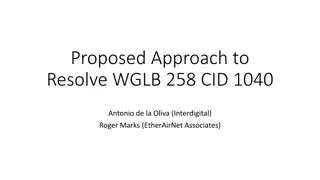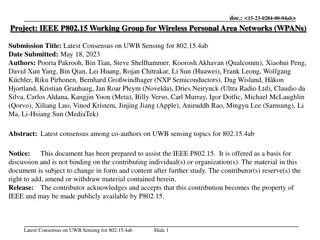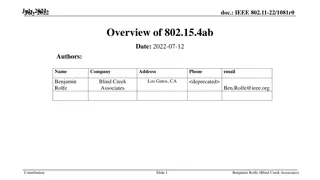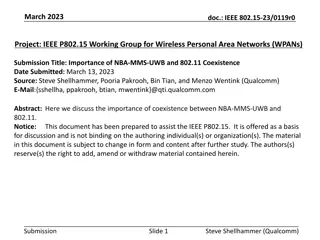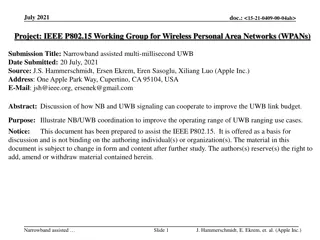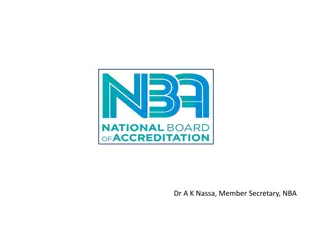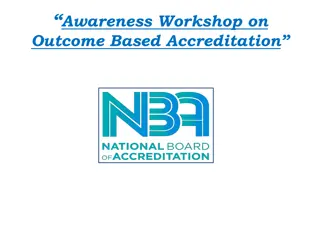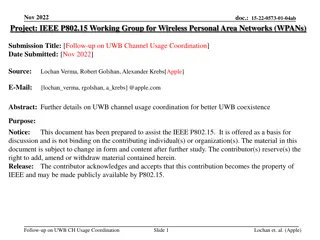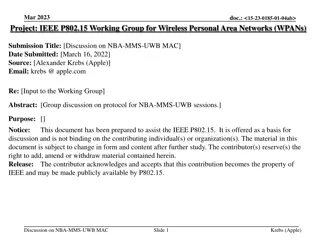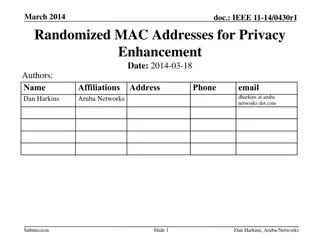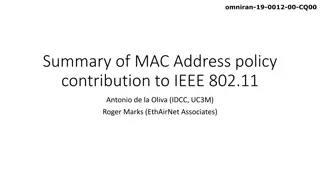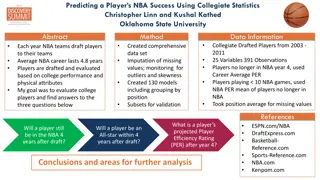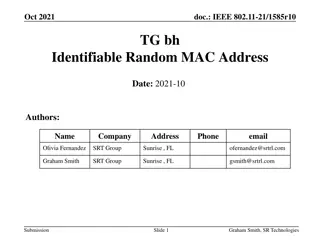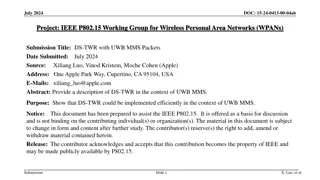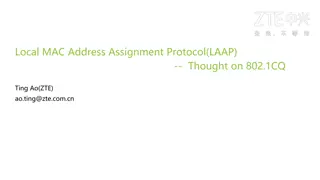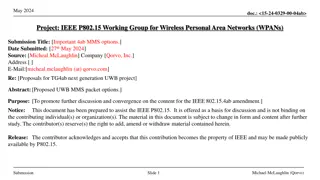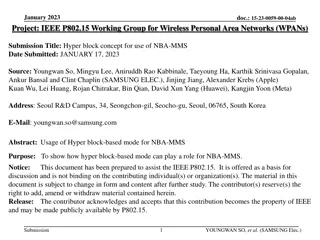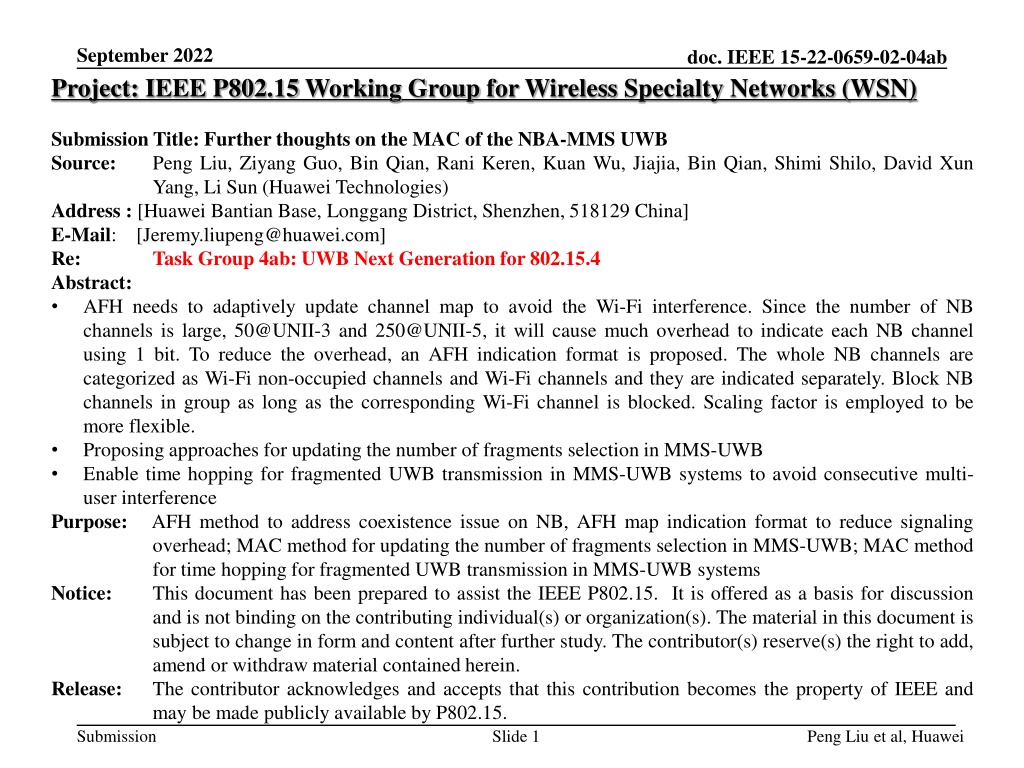
Innovative MAC and AFH Methods for UWB Networks Coexistence
Explore advanced MAC strategies and Adaptive Frequency Hopping (AFH) techniques proposed by Huawei for Ultra-Wideband (UWB) networks, addressing coexistence challenges with Wi-Fi interference and enhancing data throughput and reliability. The document provides insights into channel map adaptation, fragmentation selection, time hopping, and other key improvements to optimize UWB performance in diverse scenarios.
Download Presentation

Please find below an Image/Link to download the presentation.
The content on the website is provided AS IS for your information and personal use only. It may not be sold, licensed, or shared on other websites without obtaining consent from the author. Download presentation by click this link. If you encounter any issues during the download, it is possible that the publisher has removed the file from their server.
E N D
Presentation Transcript
September 2022 doc. IEEE 15-22-0659-02-04ab Project: IEEE P802.15 Working Group for Wireless Specialty Networks (WSN) Submission Title: Further thoughts on the MAC of the NBA-MMS UWB Source: Peng Liu, Ziyang Guo, Bin Qian, Rani Keren, Kuan Wu, Jiajia, Bin Qian, Shimi Shilo, David Xun Yang, Li Sun (Huawei Technologies) Address : [Huawei Bantian Base, Longgang District, Shenzhen, 518129 China] E-Mail: [Jeremy.liupeng@huawei.com] Re: Task Group 4ab: UWB Next Generation for 802.15.4 Abstract: AFH needs to adaptively update channel map to avoid the Wi-Fi interference. Since the number of NB channels is large, 50@UNII-3 and 250@UNII-5, it will cause much overhead to indicate each NB channel using 1 bit. To reduce the overhead, an AFH indication format is proposed. The whole NB channels are categorized as Wi-Fi non-occupied channels and Wi-Fi channels and they are indicated separately. Block NB channels in group as long as the corresponding Wi-Fi channel is blocked. Scaling factor is employed to be more flexible. Proposing approaches for updating the number of fragments selection in MMS-UWB Enable time hopping for fragmented UWB transmission in MMS-UWB systems to avoid consecutive multi- user interference Purpose: AFH method to address coexistence issue on NB, AFH map indication format to reduce signaling overhead; MAC method for updating the number of fragments selection in MMS-UWB; MAC method for time hopping for fragmented UWB transmission in MMS-UWB systems Notice: This document has been prepared to assist the IEEE P802.15. It is offered as a basis for discussion and is not binding on the contributing individual(s) or organization(s). The material in this document is subject to change in form and content after further study. The contributor(s) reserve(s) the right to add, amend or withdraw material contained herein. Release: The contributor acknowledges and accepts that this contribution becomes the property of IEEE and may be made publicly available by P802.15. Slide 1 Submission Peng Liu et al, Huawei
doc. IEEE 15-22-0659-02-04ab September 2022 PAR Objective Proposed Solution (how addressed) Lower duty-cycle maybe helpful Safeguards so that the high throughput data use cases will not cause significant disruption to low duty-cycle ranging use cases Interference mitigation techniques to support higher density and higher traffic use cases Other coexistence improvement Backward compatibility with enhanced ranging capable devices (ERDEVs) Improved link budget and/or reduced air-time Interference mitigation technique to support higher density of fragmented UWB ranging pairs Discussion on MMS UWB ranging for extended range Additional channels and operating frequencies Improvements to accuracy / precision / reliability and interoperability for high-integrity ranging Reduced complexity and power consumption AFH method to address coexistence issue on NB, AFH map indication format to reduce signaling overhead Time-hopping for fragment transmission to avoid consecutive interferences Discussion on NBA UWB ranging sequence messages Hybrid operation with narrowband signaling to assist UWB Enhanced native discovery and connection setup mechanisms Sensing capabilities to support presence detection and environment mapping Low-power low-latency streaming Higher data-rate streaming allowing at least 50 Mbit/s of throughput Support for peer-to-peer, peer-to-multi-peer, and station-to- infrastructure protocols Infrastructure synchronization mechanisms Submission Slide 2 Peng Liu et al, Huawei
September 2022 doc. IEEE 15-22-0659-02-04ab Introduction This contribution discusses three MAC aspects of NBA-MMS UWB. 1. Adaptive Frequency Hopping (AFH) 2. Updating the number of MMS fragments 3. Time-hopping MMS UWB Ranging Block Ranging Round Ranging Round Ranging Round slot slot slot slot slot slot slot slot slot UWB UWB NB NB Initiator UWB NB UWB NB UWB UWB Responder NB operates at UNII-3/UNII-5. Coexistence challenges/issues of NB with Wi-Fi have been discussed in [1] Submission Slide 3 Peng Liu et al, Huawei
September 2022 doc. IEEE 15-22-0659-02-04ab Topic 1: Adaptive Frequency Hopping (AFH) Submission Slide 4 Peng Liu et al, Huawei
September 2022 doc. IEEE 15-22-0659-02-04ab AFH Agile/Adaptive Frequency Hopping (AFH) is an efficient technique to avoid/mitigate Wi-Fi interference [1-2]. Especially for in-device interference, e.g., for NBA-MMS-UWB and Wi-Fi working within the same device, NBA-MMS-UWB can block the operating Wi-Fi channels and hop within other channels. AFH adopts a channel map (AFH Map) to indicate AllowList/BlockList. When the Wi-Fi interference changes, the AFH Map needs to be updated adaptively. Hence, new Information Element (IE), i.e., AFH CMD needs to be designed to sync AFH MAP. AFH CMD may contain AFH MAP and its effective time instant. initiator responder NB AFH CMD Wi-Fi . . . Frequency AFH CMD AFH illustration Submission Slide 5 Peng Liu et al, Huawei
September 2022 doc. IEEE 15-22-0659-02-04ab AFH Map Format (1) Based on the observation in [1], in UNII-3 and UNII-5, several frequency bands are not occupied by Wi-Fi, we suggest to use them in priority. For example, distinguishing them with other spectrum in channel mapping updating indication. UNII-3(5725-5850) 5730 5725 5735 5740 5745 5750 Wi-Fi ch 144 153 149 NB ch 1 2 3 4 5 6 7 8 9 10 11 12 13 14 15 16 17 18 19 20 To reduce the signaling overhead (50bits ->12bits) of updating AFH Map between initiator and responder, we propose the following IE. B11 B9 B0 B3 Wi-Fi non-occupied channels Wi-Fi channels (20MHz) Scaling Factor (SF) UNII-3 channels as example B0-B3: indicate Wi-Fi non-occupied channels, for UNII-3, they are NB ch 1~4 B4-B9: indicate Wi-Fi channels (20MHz), (B4,149), (B5,153), ,(B9,169); It is used to block NB channels in group, which is more efficient and able to reduce overhead. B10B11->SF: for example, 00->1/2; 01->3/4; 10->1;11->5/4. SF is flexible to indicate the ratio of total unused NB bandwidth to the Wi-Fi channel bandwidth (20MHz). See next page for details Submission Slide 6 Peng Liu et al, Huawei
September 2022 doc. IEEE 15-22-0659-02-04ab AFH Map Format (2) UNII-3(5725-5850) 5730 5725 5735 5740 5745 5750 Wi-Fi ch 144 153 149 SF = 3/4 NB ch 1 2 3 4 5 6 7 8 9 10 11 12 13 14 15 16 17 18 19 20 B11 B9 B0 B3 Wi-Fi non-occupied channels Wi-Fi channels (20MHz) Scaling Factor (SF) 111101111101 AFH Map IE B4 = 0, indicating there exists Wi-Fi interference on Wi-Fi channel 149 B10B11 = 01, indicating the SF = 3/4 Combining the interfered channel and SF, there is 20*3/4=15MHz of Wi-Fi channel 149 being blocked, which corresponds to NB channel 6-11, i.e., the unused NB channels are 6-11. If B10B11 = 10, SF = 1, the unused NB channels are 5-12. Submission Slide 7 Peng Liu et al, Huawei
September 2022 doc. IEEE 15-22-0659-02-04ab Time Sequence Example Ranging Round T Ranging Round T+X AFH CMD (new AFH MAP) current AFH MAP = new AFH MAP slot slot slot slot slot slot slot slot slot AFH CMD NB UWB UWB NB Initiator UWB ACK UWB NB NB UWB UWB Responder AFH CMD contains (new) AFH MAP AFH CMD is sent by initiator at slot 0 of a ranging round Responder replies ACK if it received AFH CMD from Initiator (new) AFH MAP will be effective at the next X ranging round, X could be 1 by default or indicated in AFH CMD Submission Slide 8 Peng Liu et al, Huawei
September 2022 doc. IEEE 15-22-0659-02-04ab Topic 2: On the selection of the number of MMS fragments Submission Slide 9 Peng Liu et al, Huawei
September 2022 UWB channel probing measurement phase doc. IEEE 15-22-0659-02-04ab Recap of the background: Signal level between UWB and NB signals in an indoor multipath environment [3] shows that inferring the UWB signal level from a given NB signal level is expected to have low reliability due to the NB multipath fading effect. Therefore, direct UWB channel probing is required. Proposed solution [4]: At the measurement report phase of each MMS ranging round, the responder may request the controller to change the number of fragments in the following round(s). The request may be accompanied by a NB feedback message containing a link margin report to the controller. Based on the feedback message, the controller may determine an updated number of fragments to be used in the following round(s). Submission Slide 10 Peng Liu et al, Huawei
September 2022 doc. IEEE 15-22-0659-02-04ab Topic 3: Time-hopping MMS UWB Submission Slide 11 Peng Liu et al, Huawei
September 2022 doc. IEEE 15-22-0659-02-04ab Time-hopping MMS UWB In the case of MMS packets to mitigate non-coordinated multi-user interference, the following numerology is recommended [5] The number of ranging sequence fragment X and the number of ranging integrity fragment Y can be flexibly configured as follows With NB assistance: X {1, 2, 4, 8}, Y {1, 2, 4, 8} Without NB assistance: X {0, 1, 2, 4, 8}, Y {1, 2, 4, 8} The duration of the ranging slot is (1+T) ms, where T {0, 0.5, 1}. When T is nonzero, there are N equally distributed hopping positions within the first Tms duration, where N {2, 4, 8, 16}. The n-th hopping position of the x-th fragment is denoted as ??,? ? ??,?= ??+ ? ? 1 where ?? is the start time of the x-th ranging slot, ??= ?0+ (? 1)(1 + ?), and ? [0, N]. Ranging sequence fragment and/or ranging integrity fragment could randomly hop among N hopping positions within one time hopping based ranging slot. Submission Slide 12 Peng Liu et al, Huawei
September 2022 doc. IEEE 15-22-0659-02-04ab Summary Topic 1: Adaptive Frequency Hopping (AFH) Apply AFH in NB to mitigate Wi-Fi interference, use Wi-Fi non-occupied spectrum in priority. The new Information Element (IE) is proposed to indicate AFH map, which is efficient and flexible Topic 2: On the selection of the number of MMS fragments Bi-directional UWB channel probing is performed during measurement phase and a resulting update of number of fragments is applied in the following round Topic 3: Time-hopping MMS UWB Time hopping scheme is proposed to mitigate the consecutive interference for fragmented UWB transmission Submission Slide 13 Peng Liu et al, Huawei
September 2022 doc. IEEE 15-22-0659-02-04ab References [1] 15-22-0261-04ab Coexistence discussion on narrowband assisted UWB (May 2022), Bin Tian, et al [2] Z. Guo, P. Liu, C. Zhang, J. Luo, Z. Long and X. Yang, "AI-Aided Channel Quality Assessment for Bluetooth Adaptive Frequency Hopping," 2021 IEEE 32nd Annual International Symposium on Personal, Indoor and Mobile Radio Communications 10.1109/PIMRC50174.2021.9569405. (PIMRC), 2021, pp. 934-939, doi: [3] RECOMMENDATION ITU-R SM.1755-0, Characteristics of ultra-wideband technology, 2006 [4] 15-22-0378-00-04ab-on-the-selection-of-number-of-fragments-in-mms-uwb (July 2022), Rani Keren, Kuan Wu, et al [5] 15-22-0289-01-04ab-time-hopping-for-fragmented-uwb-transmission-in-mms-uwb-systems (May 2022), Ziyang Guo, et al Submission Slide 14 Peng Liu et al, Huawei

